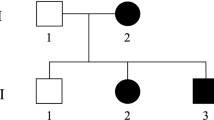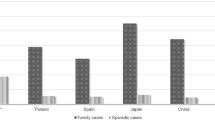Abstract
SPG31 is an autosomal dominant hereditary spastic paraplegia caused by pathogenic variants in the receptor expression-enhancing protein 1 (REEP1) gene. We analyzed 488 DNA samples from unrelated HSP patients collected by Japan Spastic Paraplegia Research Consortium and found 15 Japanese SPG31 families. We investigated each family and found a total of 25 individuals with REEP1 variants (comprising 22 patients and three asymptomatic carriers). Fourteen REEP1 variants (five missense, three nonsense, four frameshift, one splice site, and one large deletion) including 11 novel ones were detected. Seventy percent of the patients (14 of 20) showed a pure form and the others (6 of 20) showed a complicated form with peripheral neuropathy. Fifty percent of the patients had neurological symptoms before the age of 10 and 20% of them at age 41–50. The mean age of onset was 19.6 ± 18.7 (from 5 to 67, n = 15) years for males and 32.8 ± 24.7 (from 4 to 60, n = 5) years for females. Although the difference was not statistically significant (p = 0.38, Mann–Whitney U test), males tended to have an earlier age of onset. Moreover, all three asymptomatic carriers were female. We investigated additional factors as to phenotypic appearance in one family with apparent intrafamilial variability in age at onset and clinical severity, but no additional factors including gene variants could be found. This is the first report of clinical and genetic findings of SPG31 in Japan, which may lead to further studies of the genotype–phenotype correlation of SPG31.
This is a preview of subscription content, access via your institution
Access options
Subscribe to this journal
Receive 12 print issues and online access
$259.00 per year
only $21.58 per issue
Buy this article
- Purchase on Springer Link
- Instant access to full article PDF
Prices may be subject to local taxes which are calculated during checkout




Similar content being viewed by others
References
Zuchner S, Wang G, Tran-Viet K-N, Nance MA, Gaskell PC, Vance JM, et al. Mutations in the novel mitochondrial protein REEP1 cause hereditary spastic paraplegia type 31. Am J Hum Genet. 2006;79:365–9.
Toft A, Birk S, Ballegaard M, Dunø M, Hjermind LE, Nielsen JE, et al. Peripheral neuropathy in hereditary spastic paraplegia caused by REEP1 variants. J Neurol. 2019;266:735–44.
Beetz C, Schule R, Deconinck T, Tran-Viet K-N, Zhu H, Kremer BPH, et al. REEP1 mutation spectrum and genotype/phenotype correlation in hereditary spastic paraplegia type 31. Brain. 2008;131:1078–86.
Schlang KJ, Arning L, Epplen JT, Stemmler S. Autosomal dominant hereditary spastic paraplegia: novel mutations in the REEP1 gene (SPG31). BMC Med Genet. 2008;9:71.
Goizet C, Depienne C, Benard G, Boukhris A, Mundwiller E, Sole G, et al. REEP1 mutations in SPG31: frequency, mutational spectrum, and potential association with mitochondrial morpho-functional dysfunction. Hum Mutat. 2011;32:1118–27.
Hewamadduma C, McDermott C, Kirby J, Grierson A, Panayi M, Dalton A, et al. New pedigrees and novel mutation expand the phenotype of REEP1-associated hereditary spastic paraplegia (HSP). Neurogenetics. 2009;10:105–10.
Du J, Shen L, Zhao GH, Wang YG, Liao SS, Chen C, et al. Receptor expression-enhancing protein 1 gene (SPG31) mutations are rare in Chinese Han patients with hereditary spastic paraplegia. Chin Med J (Engl). 2009;122:2064–6.
Kim T-H, Lee J-H, Park Y-E, Shin J-H, Nam T-S, Kim H-S, et al. Mutation analysis of SPAST, ATL1, and REEP1 in Korean patients with hereditary spastic paraplegia. J Clin Neurol. 2014;10:257–61.
Ishiura H, Takahashi Y, Hayashi T, Saito K, Furuya H, Watanabe M, et al. Molecular epidemiology and clinical spectrum of hereditary spastic paraplegia in the Japanese population based on comprehensive mutational analyses. J Hum Genet. 2014;59:163–72.
Koh K, Ishiura H, Tsuji S, Takiyama Y. JASPAC: Japan Spastic Paraplegia Research Consortium. Brain Sci. 2018;8:153.
Park HJ, Lee MJ, Lee JE, Park KD, Choi Y-C. Pathogenic variant of REEP1 in a Korean family with autosomal-dominant hereditary spastic paraplegia. J Clin Neurol. 2018;14:248–50.
Kamada M, Kawarai T, Miyamoto R, Kawakita R, Tojima Y, Montecchiani C, et al. Spastic paraplegia type 31: a novel REEP1 splice site donor variant and expansion of the phenotype variability. Parkinsonism Relat Disord. 2018;46:79–83.
Richard S, Lavie J, Banneau G, Voirand N, Lavandier K, Debouverie M. Hereditary spastic paraplegia due to a novel mutation of the REEP1 gene: case report and literature review. Medicine (Baltimore). 2017;96:e5911.
Beetz C, Pieber TR, Hertel N, Schabhuttl M, Fischer C, Trajanoski S, et al. Exome sequencing identifies a REEP1 mutation involved in distal hereditary motor neuropathy type V. Am J Hum Genet. 2012;91:139–45.
Parodi L, Fenu S, Barbier M, Banneau G, Duyckaerts C, Tezenas du Montcel S, et al. Spastic paraplegia due to SPAST mutations is modified by the underlying mutation and sex. Brain. 2018;141:3331–42.
Proukakis C, Moore D, Labrum R, Wood NW, Houlden H. Detection of novel mutations and review of published data suggests that hereditary spastic paraplegia caused by spastin (SPAST) mutations is found more often in males. J Neurol Sci. 2011;306:62–65.
Orlacchio A, Kawarai T, Gaudiello F, Totaro A, Schillaci O, Stefani A, et al. Clinical and genetic study of a large SPG4 Italian family. Mov Disord. 2005;20:1055–9.
Mitne-Neto M, Kok F, Beetz C, Pessoa A, Bueno C, Graciani Z, et al. A multi-exonic SPG4 duplication underlies sex-dependent penetrance of hereditary spastic paraplegia in a large Brazilian pedigree. Eur J Hum Genet. 2007;15:1276–9.
Simpkins JW, Singh M. More than a decade of estrogen neuroprotection. Alzheimers Dement. 2008;4:S131–S136.
Schumacher M, Guennoun R, Robert F, Carelli C, Gago N, Ghoumari A, et al. Local synthesis and dual actions of progesterone in the nervous system: neuroprotection and myelination. Growth Horm IGF Res. 2004;14(Suppl A):S18–33.
Park SH, Zhu PP, Parker RL, Blackstone C. Hereditary spastic paraplegia proteins REEP1, spastin, and atlastin-1 coordinate microtubule interactions with the tubular ER network. J Clin Invest. 2010;120:1097–110.
Fink JK. Hereditary spastic paraplegia: clinico-pathologic features and emerging molecular mechanisms. Acta Neuropathol. 2013;126:307–28.
Acknowledgements
We thank all the participants and cooperating doctors in the Japan Spastic Paraplegia Research Consortium. The following programs provided financial support to the conduct of this research, including the study design, collection, analysis and interpretation of data, and writing of the manuscript: Grants-in-Aid from the Research Committee for Ataxic Disease (YT) the Ministry of Health, Labor and Welfare, Japan, and JSPS KAKENHI Grant Numbers 19K16910 (KK) and JP21K07456 (YT) from the Ministry of Education, Culture, Sports, Science, and Technology, Japan.
Author information
Authors and Affiliations
Contributions
TH and YT designed and organized the study. TH acquired the clinical and laboratory data. TH, HN, KK and HI carried out the molecular genetic studies, and TH, ST and YT analyzed the molecular and clinical data. TH wrote the manuscript, which was edited by HI, ST and YT. All authors have read and approved the final version of the manuscript submitted by YT.
Corresponding author
Ethics declarations
Competing interests
The authors declare no competing interests.
Additional information
Publisher’s note Springer Nature remains neutral with regard to jurisdictional claims in published maps and institutional affiliations.
Supplementary information
Rights and permissions
About this article
Cite this article
Hata, T., Nan, H., Koh, K. et al. A clinical and genetic study of SPG31 in Japan. J Hum Genet 67, 421–425 (2022). https://doi.org/10.1038/s10038-022-01021-4
Received:
Revised:
Accepted:
Published:
Issue Date:
DOI: https://doi.org/10.1038/s10038-022-01021-4



